Toyota Camry 1998 model year refers to a generation XV20, launched in mass production in late summer 1996. Initially factories Toyota offered cars with a 4-door sedan body, but since 1998 in the production program appeared the original 2-door coupe under its own designation Solara. The cars intended for the markets in Europe, Asia, North America and Australia, have differences, dictated by local legislative requirements.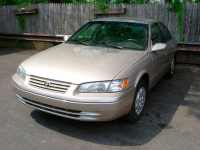 Development history of the 1998 model range
Development history of the 1998 model range
The XV20 began development by Toyota in mid-1991, with Kosaku Yamada as project manager. Prototypes of the car under the codename 415T were built two years later, and in early February 1994 the design of a new generation of Toyota Camry was approved.
At the same time a new family of Corolla sedans was developed. In 1995, the first official photos were published, and a year later shipments of serial cars to customers began.
Various modifications on the market
The Toyota Camry was produced at Toyota plants in Japan, Australia, the U.S. and Indonesia. On the Australian market, in addition to the sedan version, cars were offered with a station wagon body, equipped with an upward swinging door of the luggage compartment.
The cars came in CSi, Conquest and CSX versions, which differed in equipment level and the list of available options. There was also a version Vienta with improved interior trim and a V-shaped power unit.
On the Japanese market, the cars were offered under the designations Camry Gracia (sedan) and Mark II Qualis (station wagon). Sedan with a 2.2-liter engine is also sold as Daihatsu Altis.
The XV20 generation was also sold in the Middle East market, the manufacturer offered XLI and GLI versions with a 4-cylinder engine, the version with a V-shaped power unit had the designation Grande (distinguished by improved interior decoration).
Since 1997, 2.2GL and 3.0GX sedan models were available for the European market. The 4-cylinder version could be equipped with automatic or manual transmission, while the 6-cylinder versions were offered only with automatic transmission.
In the U.S. market, the Camry was sold with sedan and station wagon bodies, the cars are distinguished by headlights and taillights that meet local requirements.
Toyota Racing Development supplied a V-engine performance kit through authorized dealers. The parts kit included a supercharger to boost power to 247 hp (peak torque reached 328 Nm, on the standard motor the parameter did not exceed 283 Nm).
Since 1998, customers were offered a two-door coupe Camry Solara, body style was different from the sedan.
Vehicle Appearance
The car is equipped with an all-metal body with narrow headlights and separate directional indicator blocks. The bumpers and mirrors are painted in the main color, the doors are equipped with rubber protective moldings. The bumpers are designed to withstand a collision with a stationary obstacle at speeds up to 10 km/h. Cars for the Japanese market were equipped with decorative plastic coverings for the doors and the front fender, located below the moldings.
Toyota Camry has semicircular wheel arches, standard versions are equipped with 14-inch stamped rims with decorative hubcaps. The improved versions were equipped with 15-inch wheels, made by casting of light alloy. Body painting used standard enamels and metallic paint, but the two-tone paint is not offered by the factories.
 Door handles on some trucks are black; body-colored elements are offered for more expensive modifications.
Door handles on some trucks are black; body-colored elements are offered for more expensive modifications.
Camry interior
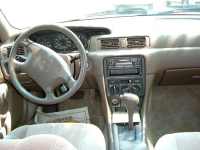 Soft plastic is used in the interior of the car, the dashboard and door cards have overlays with wood imitation coating. The cars used air conditioning with manual control (basic equipment), but most of the released cars received a climate control system. The push-button control unit is equipped with an LCD screen. The cars used OEM stereo with a laser disc player, and speakers are installed in the lower part of the doors.
Soft plastic is used in the interior of the car, the dashboard and door cards have overlays with wood imitation coating. The cars used air conditioning with manual control (basic equipment), but most of the released cars received a climate control system. The push-button control unit is equipped with an LCD screen. The cars used OEM stereo with a laser disc player, and speakers are installed in the lower part of the doors.
The front seats are manually adjustable for distance from the engine compartment and backrest angle, with seat height adjustment and lumbar support adjustment. The rear sofa for 3 people is equipped with a folding backrest. The seats are upholstered in velour or natural leather (the type of material depends on the configuration), and the driver's and front passenger's seats are heated. Door panels are equipped with decorative inserts of the same material as the seat upholstery.
Luggage compartment and interior volume
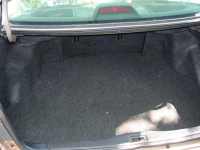 The car is designed to carry 5 passengers and additional cargo in the luggage compartment (total load - not more than 475 kg). The volume of the luggage compartment is 520 liters, the spare wheel is located under the removable floor panel in a special niche. To increase the capacity of the luggage compartment, the backrest of the rear row of seats can be folded down. To transport additional cargo, the trailer is used, the towing device is set by the owner.
The car is designed to carry 5 passengers and additional cargo in the luggage compartment (total load - not more than 475 kg). The volume of the luggage compartment is 520 liters, the spare wheel is located under the removable floor panel in a special niche. To increase the capacity of the luggage compartment, the backrest of the rear row of seats can be folded down. To transport additional cargo, the trailer is used, the towing device is set by the owner.
The permissible weight of the trailer, equipped with brakes, is 1500 kg.
Safety of the '98 Camry
The car is designed with front and side (located in the backs of the driver and front passenger seats) airbags. The body is equipped with power elements made of alloy steel, with reinforcements inside the doors. During the certification tests (before the beginning of sales in Europe) according to Euro NCAP methodology the sedan received 4 stars out of 5 possible. The impact sensors are mounted on the side members or are located inside the airbag control unit (the place of installation and type of sensor depend on the market).
The car is equipped with disc brakes front and rear (the cars for the American market used rear drum mechanisms), anti-lock braking system with electronic brake force regulator is standard equipment. Front seat belts are equipped with pyrotechnic cartridge locks that deploy simultaneously with the airbags. To improve driving safety, headlight washers are used (offered only for the Scandinavian market).
Engine and transmission
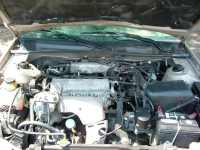 The 1998 Toyota Camry was offered to customers with gasoline engines:
The 1998 Toyota Camry was offered to customers with gasoline engines:
5S-FE inline four-cylinder, which developed 131 horsepower with a displacement of 2184 cm³;
V-type 6-cylinder 1MZ-FE, which has 190 horsepower and a working volume of 2995 cm³;
In-line 4-cylinder 2MZ-FE, which developed 174 hp at 2500 cm³ (offered in Japan).
There was a limited edition with 5S-FE engine, equipped with a system of distributed injection of natural gas. The power unit is located across the engine compartment, with the engine and transmission mounted to the subframe on hydraulic mounts. The standard equipment was 5-speed synchronized transmission S51 series with dry clutch.
The range included 4-speed hydraulic automatic transmission A140E and A541E models. Axles with joints were used to transmit torque to the front wheels.
Advantages and disadvantages of Toyota Camry
Advantages of the 1998 Toyota Camry car:
reliable engine and transmission;
strong body metal;
high quality machining and painting of the body;
comfortable interior;
no vibrations on the controls;
low cost of spare parts;
no special tools are needed for the repair.
The power units have a service life of up to 600-700 thousand km, the timing belt is used to drive the timing mechanism. The valves do not collide with the pistons when they break (since there is no VVTi phase adjustment mechanism). When servicing the drive, it is recommended to replace the rollers and the pump, as well as to fill the cooling system with fresh antifreeze. In order to increase the engine life, it is recommended to perform maintenance every 6-7 thousand km and use synthetic engine oil.
The disadvantages of the car are weak suspension, not designed for broken roads. When servicing the running gear, you have to replace the joints and deformed levers. Low ground clearance does not allow driving on forest and country roads, the car hurts the roughness with bumpers and sills. Average fuel consumption in the city does not fall below 13 liters per 100 kilometers (for the engine 2.2 liters), because of the high mileage increases oil consumption and piston rings.
Toyota does not supply floating joints of rear suspension arms on the market of spare parts (parts life is less than 200 thousand km). When using counterparts worsens the stability of the vehicle when driving at high speeds. The body is made of galvanized steel sheet, if the car is not damaged in an accident, it is impossible to find traces of rotting. Artificially restored body parts rot through in 2-3 winters due to the impact of road reagents.
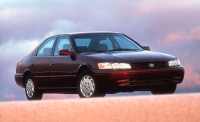

-rear-and-front-view-camera-6.png)

